Xylophanes thyelia
|
|
Updated as per
AN ANNOTATED CHECKLIST OF THE SPHINGIDAE OF BOLIVIA, October 2007
Updated as per More, Kitching and Cocucci's Hawkmoths of Argentina 2005, October, 2007
Updated as per CATE Sphingidae; February 2010.
Updated as per personal communication with Johan van't Bosch (Brownsberg National Park, Brokopondo, Suriname, July 10, 2011); November 21, 2012
Updated as per personal communication with Ezequiel Bustos (Shilap revta. lepid. 43 (172) diciembre, 2015, 615-631 eISSN 2340-4078 ISSN 0300-5267), January 4, 2016
Updated as per personal communication with Gernot Kunz (El Copan, Cartago, Costa Rica, March 6, 2019, 1047m); April 17, 2019
|
Xylophanes thyelia thyelia
zail-AH-fan-eesMthigh-EEL-ee-uh
(Linnaeus, 1758) Sphinx
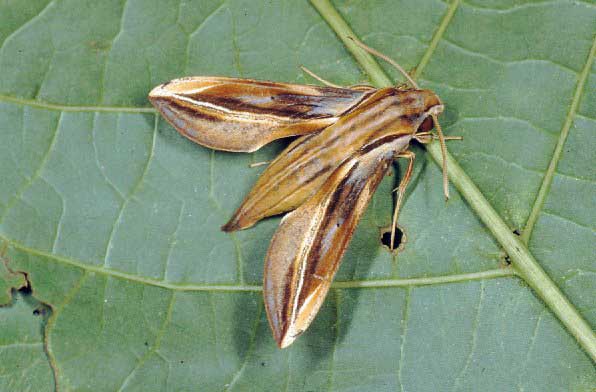
Xylophanes thyelia courtesy of Paolo Mazzei,
Rancho Grande, H. Pittier National Park, Venezuela.
This site has been created by Bill Oehlke.
Comments, suggestions and/or additional information are welcomed by Bill.
TAXONOMY:
Family: Sphingidae, Latreille, 1802
Subfamily: Macroglossinae, Harris, 1839
Tribe: Macroglossini, Harris, 1839
Genus: Xylophanes Hubner [1819] ...........
Species: thyelia Linnaeus, 1758
|
DISTRIBUTION:
Xylophanes thyelia moths [wingspan 53-54 mm]
fly from Mexico to Guatemala, Costa Rica: Cartago (GK);
probably throughout Central America to
Ecuador and Peru (South America is given as the specimen
type locality.) and further south into
Bolivia: Santa Cruz: Ichilo, Parque Nacional
Amboró, Río Saguayo; La Víbora; Guarayos, Perseverancia;
La Paz: Murillo, Río Zongo, (750m);
Argentina: Misiones: Iguazu;
(possibly Paraguay: (Itapua (WO??)).
CATE also shows it in French Guiana and eastern Brazil.
Johan van't Bosch confirms it in Suriname: Brokopondo District: Brownsberg National Park.
Chaerocampa eson Walker, 1856, [South America], is the same as Xylophanes thyelia thyelia.
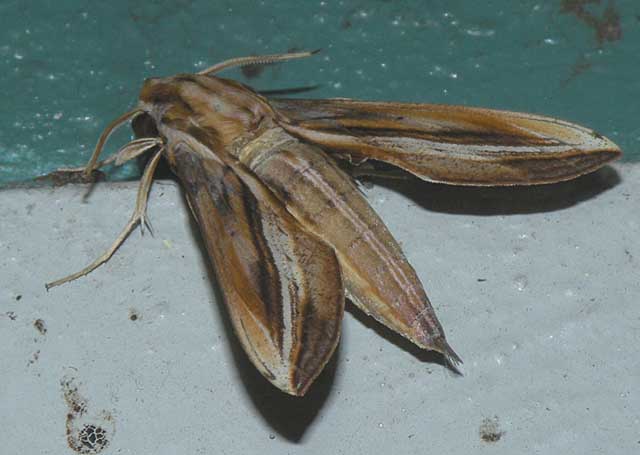
Xylophanes thyelia, Brownsberg National Park, Brokopondo, Suriname,
July 10, 2011, courtesy of Johan van't Bosch.
Xylophanes thyelia has visible characters making it similar to members of the Xylophanes ceratomioides group, but it is a much smaller species.
The head has a dark longitudinal line, bordered ventrally with buff, above the antenna. The tegula have a dark brown median line, bordered on each side by a pale grey stripe,
irrorated with pale purple.
The abdomen has a brown midline, bordered by narrow grey lines; a brown lateral line present on segments 2-4, bordered ventrally by a pale buff line that continues
posteriorly to segment 7.
The forewing upperside is dark brown and buff. There is a short dark line present basal to the first postmedian line, reaching as far as the discal spot.
First, second and third postmedian lines arise almost from the wing base and are quite oblique. The first postmedian line reaches to just beyond M1;
the second postmedian line reaches Rs4; the third and fourth postmedian lines very narrow and close, sometimes fused for part of their length distally,
running from Rs4 to M3, below which they become a diffuse series of minute spots (continuous and distinct below M3 in Xylophanes thyelia salvini).
The area between the second and third postmedian lines, where they overlap, is
conspicuously pale. The fifth postmedian line runs from the apex to M3 as a gradually broadening triangular patch. There is an apical area bounded by the costa,
fifth postmedian line and Rs4, and the tornal area bounded by M3, the second postmedian line and CuA2, both pale brown and buff,
with scattered individual black scales; Rs4, basal to second postmedian line, highlighted with buff over distal half.
The forewing underside has three dark brown or black, parallel and equidistant postmedian lines.
The hindwing upperside is an almost uniform grey-brown. The median band is barely visible.
in the male, the hindtibia have long scales dorsally and ventrally, thus appearing very broad and compressed. CATE
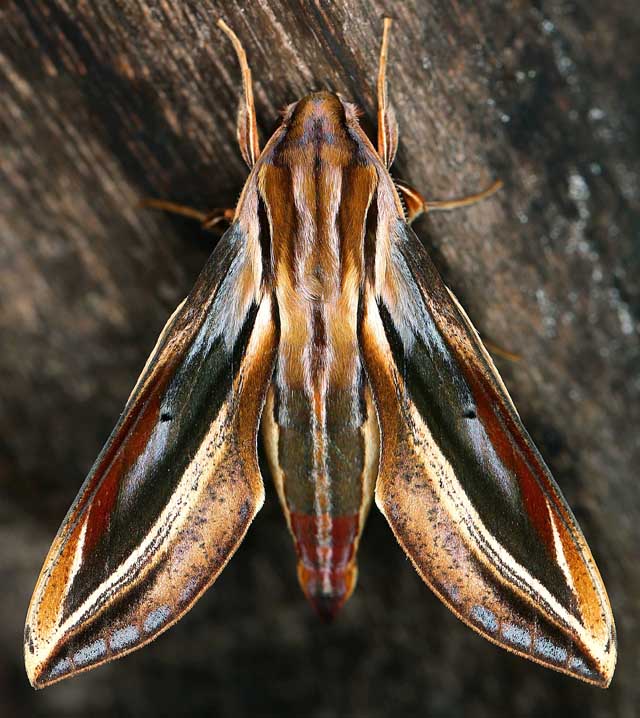
Xylophanes thyelia, El Copan, Cartago, Costa Rica,
March 6, 2019, 1047m, courtesy of Gernot Kunz.
I note that the brown terminal band running from the costa, fades into oblivion before reaching halfway to the inner margin, leaving a relatively large, evenly tan
area with some dark speckling near the anal angle.
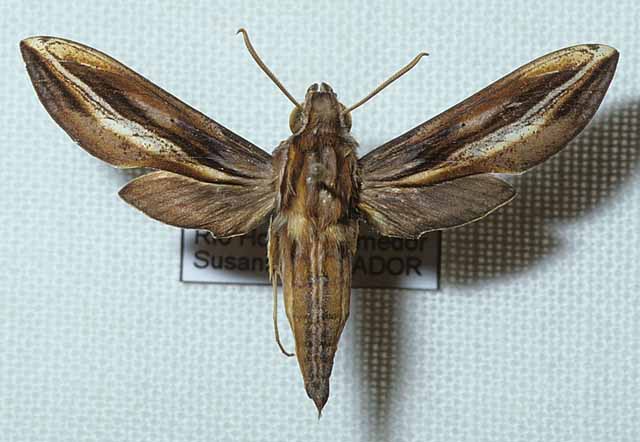
Xylophanes thyelia male courtesy of
Hubert Mayer
copyright.
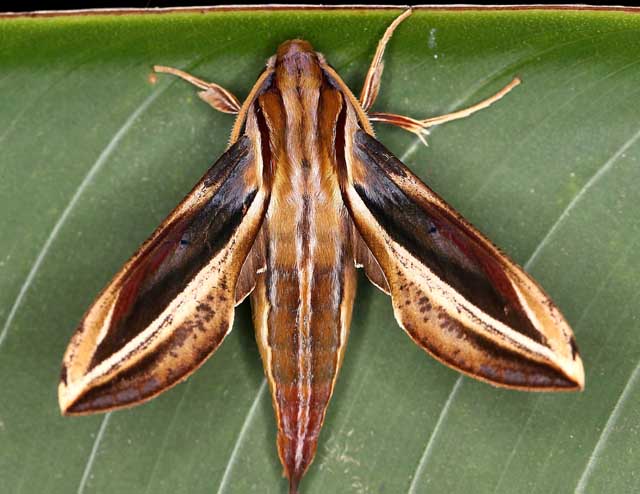
Xylophanes thyelia, El Copan, Cartago, Costa Rica,
March 6, 2019, 1047m, courtesy of Gernot Kunz.
FLIGHT TIMES:
Xylophanes thyelia adults fly
continuously in Costa Rica. In Bolivia there are records for March, October, December.
Johan van't Bosch reports a July flight in Suriname.
ECLOSION:
Pupae probably wiggle to surface from subterranean chambers or leaf litter just prior to
eclosion.
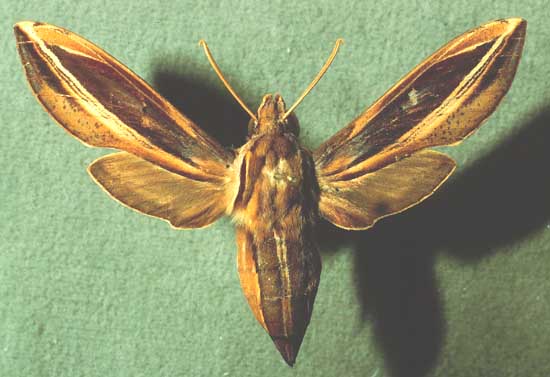
Xylophanes thyelia female courtesy of Dan Janzen.

Xylophanes thyelia female, El Copan, Cartago, Costa Rica,
March 6, 2019, 1047m, courtesy of Gernot Kunz.

Xylophanes thyelia, El Copan, Cartago, Costa Rica,
March 6, 2019, 1047m, courtesy of Gernot Kunz.
SCENTING AND MATING:Females call in the males with a pheromone released from a gland at the tip of the
abdomen. Males come in to lights very readily, but females are seldom taken in that way.

Xylophanes thyelia, El Copan, Cartago, Costa Rica,
March 6, 2019, 1047m, courtesy of Gernot Kunz.
EGGS, LARVAE, PUPAE:
The snake-like larva has a head and the three thoracic segments which may be retracted
into abdominal segment 1, which is swollen and adorned with a pair of light-ringed grey eye-spots.
The pronunciation of scientific names is
troublesome for many. The "suggestion" at the top of the page is
merely a suggestion. It is based on commonly
accepted English pronunciation of Greek names and/or some
fairly well accepted "rules" for latinized scientific names.
The suggested pronunciations, on this page and on other pages,
are primarily put forward to assist those who hear with internal
ears as they read.
There are many collectors from different countries whose
intonations and accents would be different.
Jean Marie Cadiou writes, "When I say "Xylophanes" in English I pronounce it something like "Zailophanees", with the emphasis on the
"o". The French pronounce it differently, something like "Kzeelophaness" with no emphasis, and the Germans yet in a different way..."
Some of the early describers/namers chose genus and species names indicating some character of the insect, but more
often, they simply chose names from Greek or Roman mythology or history.Those species names which end in "ensis" indicate a
specimen locale, and those which end in "i", pronounced "eye", honour a contempory friend/collector/etc.
In Greek myth, Phanes is the golden winged Primordial Being who was hatched from the shining Cosmic Egg that was the source of the
universe. He personifies light emerging from chaos.
"Xylo" is the Greek word for wood.
The specimen type for the genus Xylophanes is Xylophanes anubus. Perhaps ? when Hubner
examined that species, the yellow-orange and brown tones of the forewings suggested wings of wood.
"Thyelia" MIGHT be from Thalia (Thaleia) the "Flourishing", who is the Greek muse of comedy and of playful and idyllic poetry, and is
seen with a comic mask. She is sometimes seen with a crown of ivy and a crook. POSSIBLY the dark upper half of the
forewings, with the lighter region around the cell, reminded Linnaeus of a mask with eyespots.
Use your browser "Back" button to return to the previous page.
Goto Main Sphingidae Index
Goto Macroglossini Tribe
Goto Central American Indices
Goto Carribean Islands
Goto South American Indices
Goto U.S.A. tables








